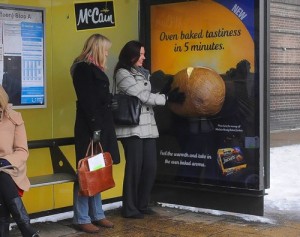Multi-sensory ads are a great revelation. But how does it affect the young and the old differently? Who has the real purchasing power?
In the middle of a conversation about the latest smart phones, a friend says, “What to do guys! My father won’t buy me this amazing gaming phone. Thanks to their action-packed ads, he thinks it is just a flashy enterprise!” Suddenly, the college group realized that even though their understanding of technology is much better, it is their parents who have the real buying power.
The marketing world today is divided amongst two categories – the ones that support the Millennials and those backing the Baby Boomers. And then there’s the dynamic entity of Multi-sensory media trying to woo the buyers. What do these terms even mean? How do they affect the marketing and consequentially, the sales of a product/service? And what are the guidelines that can help improve marketing strategy, based on these parameters?
A survey by Nielsen has some definite pointers:
The Terminology
Millennials are those who crossed into adulthood around the year 2000. Baby Boomers is the creed of babies born between 1946 and 1964 i.e. after the Second World War. This was a period when the birth rate around the world suddenly jumped; the phenomenon was referred to as ‘Baby Boom’.
It’s obvious that the Baby Boomers are parents, grandparents today. It is also unsurprising that their taste of technology is rather old – they watch the good old TV (174 hours a month), still use landline phones and their computers are mostly the bulky desktops. On the other hand, the Millennials watch much less TV (107 hours per month), 76% of them own smart phones, 73% own a laptop and 68% own a game console.
Multi-sensory Ads, an emerging trend in the new marketing world, is something that brings in the 4th dimension into advertisements. Appealing to senses apart from eyes and ears, they use smell, touch and other effects to enhance the user experience.
Marketing Research – Changing Perceptions
It is obvious from the above statistics that Millennials is the target audience of the multi-sensory ads. It is the next step in the evolution of technology and Millennials is the class that thoroughly understands technology. However, one crucial stat changes all these perceptions. The Baby Boomers control 70% of the disposable income !
This totally changes the approach with which marketing strategies are built. From ad copies to the larger marketing message, the leanings and likings of the Baby Boomers become more important. Some of the key observations that Nielsen has registered in this area are:
- Baby Boomers like good-hearted humour instead of the mean, sarcastic humour that’s trending these days
- The tone should be positive and naive. Competitive, compelling tones might upset this audience
- Instead of zany, loud music videos, they prefer storylines with sentimental, heart-touching dialogues
Marketers must reconsider their marketing lines in terms of these inferences. Even though the technology and handling of ad films has to be modern, their soul has to be warm. Multi-sensory ads will work for them if the content addresses their choices. It is not the technology but the content that acts as a turn-off for them. Yes, their senses do slow down, but if you present engaging content, it would definitely be exciting for them. 
Marketing exercise is a tricky one where a small nuance can change the whole direction. A post-graduate course on Marketing Research offered by the Northpoint Centre of Learning in Lonavala enables you to identify, explore and exploit such details of marketing. The course is supported by Nielsen through training and exclusive placement. Find out more at http://www.northpointindia.com/PostGraduatePrograms/MarketingResearch.aspx

